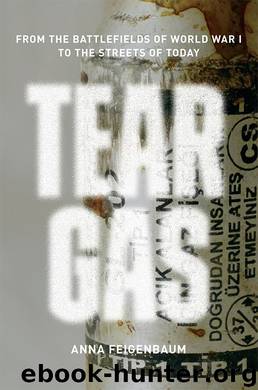Tear Gas by Anna Feigenbaum

Author:Anna Feigenbaum
Language: eng
Format: epub
Publisher: Verso Books
But in 1969, when Himsworth visited, all of this had yet to be exposed; the chemical testing facility was running business as usual, operating on what Grimley Evans describes as “wartime ethics.” In an atmosphere of perceived imminent attack, utility reigns supreme and military secrecy often overrides informed consent. On top of this, Porton Down was run by a mixed civilian and military staff. This created levels of secrecy and security clearance that made it difficult to practice any one protocol. It was hard to determine fault when things went wrong.30 Such claims to layers of organizational complexity tend to evaporate accountability in what Linsey McGoey has called “strategic ignorances.”31 The atrocity at Porton Down was not only the procedure, but the value system. What—and who—made it an issue of scientific importance to directly apply known poisons to people’s skin, lungs, and eyeballs without consent?
The results of the Porton Down experiments played a key role in the Himsworth Committee’s report. Between October 1969 and March 1971, Sir Himsworth and his team held a series of meetings at Whitehall in which they shared scientific findings, correspondence with medical professionals, and laboratory evidence. Their priorities included finding evidence of CS’s effects on the young, the elderly, and pregnant women, as well as people with previous illness. Himsworth also asked the committee to investigate cases of chemical manufacturers repeatedly exposed to CS and to gather “full details of the Vietnam experience.”32
Conspicuously absent from the agenda was any reference to the United States’ widespread use of CS and other tear gases to combat civil protests. Himsworth was silent on the crushed labor strikes, civil rights struggles, antiwar protests, and even the helicopters that sprayed CS over thousands on the Berkeley campus just four months before the team’s first meeting, all of which were heavily publicized in the United States and discussed at UN meetings on the Geneva Protocol.
The Geneva Protocol bans the use of chemical and bacteriological weapons in war. The United Kingdom and the other European Allies had signed onto the agreement in 1925. While the United States was instrumental in bringing the protocol forward and President Roosevelt made appeals to it during World War II, the United States did not ratify it until modifications were made in 1975. This position garnered international attention during its widespread use of chemical weapons in Vietnam. In 1966, the Hungarian delegation, backed by other Eastern European nations, put the matter back on the UN’s agenda. “The hollow pretexts given for using riot-control gases in Vietnam,” the Hungarians argued, “have been rejected by world public opinion and by the international scientific community, including scholars in the United States itself.” Appealing to the Geneva Protocol, Hungary called for the use of chemical weapons to constitute an international war crime.33 One prominent US scholar who rejected the use of riot-control agents in Vietnam was Nobel laureate and Harvard professor George Wald, who attested that “under combat conditions, tear gas is part of a thoroughly lethal operation.”34 But the US
Download
This site does not store any files on its server. We only index and link to content provided by other sites. Please contact the content providers to delete copyright contents if any and email us, we'll remove relevant links or contents immediately.
The Vikings: Conquering England, France, and Ireland by Wernick Robert(79845)
Ali Pasha, Lion of Ioannina by Eugenia Russell & Eugenia Russell(40103)
The Conquerors (The Winning of America Series Book 3) by Eckert Allan W(36960)
The Vikings: Discoverers of a New World by Wernick Robert(36903)
Cecilia; Or, Memoirs of an Heiress — Volume 1 by Fanny Burney(32396)
Cecilia; Or, Memoirs of an Heiress — Volume 3 by Fanny Burney(31775)
Cecilia; Or, Memoirs of an Heiress — Volume 2 by Fanny Burney(31744)
Empire of the Sikhs by Patwant Singh(22922)
The Secret History by Donna Tartt(18787)
Hans Sturm: A Soldier's Odyssey on the Eastern Front by Gordon Williamson(18448)
Cat's cradle by Kurt Vonnegut(15126)
Pimp by Iceberg Slim(14255)
Sapiens: A Brief History of Humankind by Yuval Noah Harari(14183)
Talking to Strangers by Malcolm Gladwell(13156)
Norse Mythology by Gaiman Neil(13154)
Leonardo da Vinci by Walter Isaacson(13128)
4 3 2 1: A Novel by Paul Auster(12245)
Underground: A Human History of the Worlds Beneath Our Feet by Will Hunt(11992)
The Radium Girls by Kate Moore(11886)
